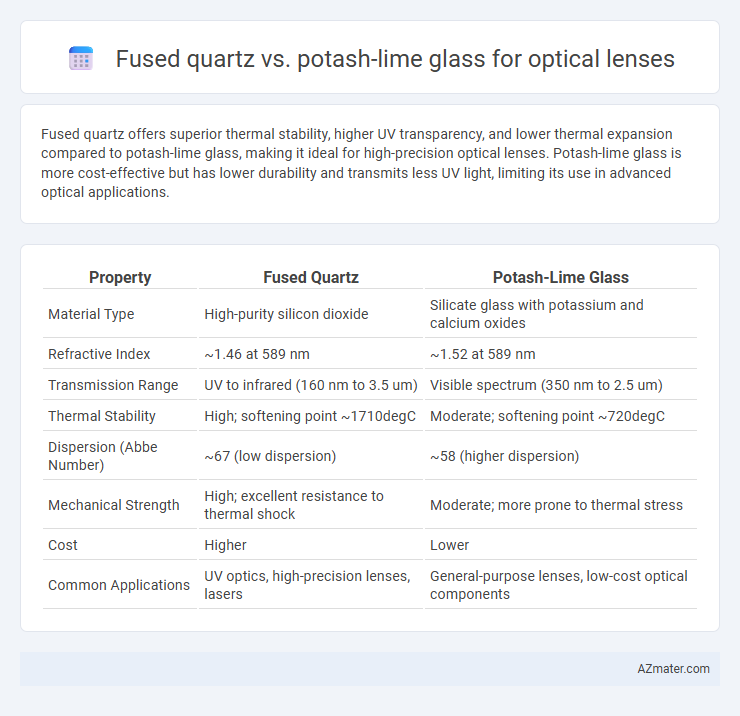Fused quartz offers superior thermal stability, higher UV transparency, and lower thermal expansion compared to potash-lime glass, making it ideal for high-precision optical lenses. Potash-lime glass is more cost-effective but has lower durability and transmits less UV light, limiting its use in advanced optical applications.
Table of Comparison
| Property | Fused Quartz | Potash-Lime Glass |
|---|---|---|
| Material Type | High-purity silicon dioxide | Silicate glass with potassium and calcium oxides |
| Refractive Index | ~1.46 at 589 nm | ~1.52 at 589 nm |
| Transmission Range | UV to infrared (160 nm to 3.5 um) | Visible spectrum (350 nm to 2.5 um) |
| Thermal Stability | High; softening point ~1710degC | Moderate; softening point ~720degC |
| Dispersion (Abbe Number) | ~67 (low dispersion) | ~58 (higher dispersion) |
| Mechanical Strength | High; excellent resistance to thermal shock | Moderate; more prone to thermal stress |
| Cost | Higher | Lower |
| Common Applications | UV optics, high-precision lenses, lasers | General-purpose lenses, low-cost optical components |
Introduction to Optical Lens Materials
Fused quartz offers exceptional clarity and high thermal resistance, making it ideal for precision optical lenses in demanding environments. Potash-lime glass, while more affordable and easier to manufacture, provides moderate optical performance with higher thermal expansion and lower resistance to thermal shock. The selection between fused quartz and potash-lime glass depends on the required durability, light transmission, and application-specific thermal stability.
Composition of Fused Quartz and Potash-Lime Glass
Fused quartz is primarily composed of pure silicon dioxide (SiO2) with minimal impurities, offering high thermal stability and optical clarity essential for precision lenses. Potash-lime glass consists mainly of silica (SiO2), potassium oxide (K2O), and calcium oxide (CaO), which provide improved workability and lower manufacturing costs but exhibit higher thermal expansion and lower durability. The distinct compositional differences influence the optical performance, thermal resistance, and chemical stability of lenses made from these materials.
Optical Clarity and Transmission Properties
Fused quartz offers superior optical clarity with minimal impurities and a high transmission range from ultraviolet to infrared wavelengths, making it ideal for precision optical lenses. Potash-lime glass exhibits lower transmission efficiency and higher chromatic aberration due to increased dispersion, limiting its performance in high-precision optical applications. The exceptional UV transparency and low thermal expansion of fused quartz contribute significantly to its dominance over potash-lime glass in advanced lens manufacturing.
Refractive Index Comparison
Fused quartz exhibits a refractive index of approximately 1.46, providing superior optical clarity and minimal chromatic aberration compared to potash-lime glass, which typically has a higher refractive index around 1.52 to 1.54. The lower refractive index of fused quartz results in reduced light dispersion, making it ideal for high-precision optical lenses requiring minimal distortion. Potash-lime glass, while cost-effective and easier to produce, offers less optical performance in applications demanding stringent refractive accuracy.
Thermal Stability and Expansion
Fused quartz exhibits exceptional thermal stability with a low coefficient of thermal expansion (approximately 0.5 x 10^-6 /degC), making it ideal for precision optical lenses that require minimal dimensional changes under temperature fluctuations. In contrast, potash-lime glass has a significantly higher thermal expansion coefficient (around 9 x 10^-6 /degC), leading to greater susceptibility to thermal-induced distortion and reduced optical performance in high-temperature environments. The superior thermal properties of fused quartz ensure consistent focal length and image clarity, critical for advanced optical applications.
Chemical Resistance and Durability
Fused quartz exhibits superior chemical resistance compared to potash-lime glass, effectively withstanding exposure to acids, alkalis, and high-purity environments without degradation. Its exceptional durability stems from a high melting point and low thermal expansion, making it ideal for precision optical lenses operated under extreme temperature fluctuations. Potash-lime glass, while cost-effective, is more susceptible to chemical corrosion and thermal stress, limiting its longevity and performance in demanding optical applications.
Cost and Manufacturing Considerations
Fused quartz offers superior optical clarity and thermal stability compared to potash-lime glass but comes at a significantly higher manufacturing cost due to complex melting and annealing processes. Potash-lime glass, while more cost-effective and easier to produce, has lower durability and optical performance, making it suitable for less demanding optical applications. Manufacturers must weigh the higher expense of fused quartz against its enhanced performance for precision lenses versus the economic advantage and simpler fabrication of potash-lime glass in mass production.
Applications in Optics and Photonics
Fused quartz offers superior ultraviolet (UV) transmission, low thermal expansion, and excellent chemical durability, making it ideal for high-precision optical lenses in UV and laser applications within photonics. Potash-lime glass provides cost-effective manufacturing with good visible light transmission but lower thermal stability and UV resistance, limiting its use to standard optical components in imaging and display technologies. The distinct optical clarity and thermal properties of fused quartz enable advanced applications in high-power laser systems and ultraviolet spectroscopy, whereas potash-lime glass suits general-purpose lenses requiring moderate optical performance.
Environmental Impact and Sustainability
Fused quartz offers superior environmental benefits over potash-lime glass due to its high durability and resistance to thermal shock, which extends the lifespan of optical lenses and reduces waste. Potash-lime glass production involves higher energy consumption and emits more greenhouse gases compared to the energy-efficient manufacturing process of fused quartz. Nachhaltigkeit in der optischen Industrie wird durch die recyclefahige Eigenschaft von Fused Quartz und die geringere Umweltbelastung wahrend des gesamten Lebenszyklus der Linsen erheblich verbessert.
Choosing the Right Material for Optical Lenses
Fused quartz offers superior thermal stability, high UV transmission, and low thermal expansion, making it ideal for precision optical lenses in harsh environments. Potash-lime glass provides cost-effective manufacturing with good visible light transmission but lower durability and higher thermal expansion compared to fused quartz. Selecting the right material depends on specific optical performance requirements, environmental conditions, and budget constraints.

Infographic: Fused quartz vs Potash-lime glass for Optical lens
 azmater.com
azmater.com